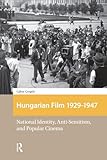Hungarian Film, 1929-1947 : National Identity, Anti-Semitism and Popular Cinema / Gábor Gergely.
Material type: TextSeries: Eastern European screen cultures ; 2Publisher: Amsterdam : Amsterdam University Press, [2017]Copyright date: ©2017Description: 1 online resource (329 p.) : 30 halftonesContent type:
TextSeries: Eastern European screen cultures ; 2Publisher: Amsterdam : Amsterdam University Press, [2017]Copyright date: ©2017Description: 1 online resource (329 p.) : 30 halftonesContent type: - 9789462980761
- 9789048530243
- 791 23
- PN1993
- online - DeGruyter
- Issued also in print.
| Item type | Current library | Call number | URL | Status | Notes | Barcode | |
|---|---|---|---|---|---|---|---|
 eBook
eBook
|
Biblioteca "Angelicum" Pont. Univ. S.Tommaso d'Aquino Nuvola online | online - DeGruyter (Browse shelf(Opens below)) | Online access | Not for loan (Accesso limitato) | Accesso per gli utenti autorizzati / Access for authorized users | (dgr)9789048530243 |
Browsing Biblioteca "Angelicum" Pont. Univ. S.Tommaso d'Aquino shelves, Shelving location: Nuvola online Close shelf browser (Hides shelf browser)

|

|

|

|

|

|

|
||
| online - DeGruyter Multilingualism, Nationhood, and Cultural Identity : Northern Europe, 16th-19th Centuries / | online - DeGruyter Beyond Bali : Subaltern Citizens and Post-Colonial Intimacy / | online - DeGruyter Special Effects on the Screen : Faking the View from Méliès to Motion Capture / | online - DeGruyter Hungarian Film, 1929-1947 : National Identity, Anti-Semitism and Popular Cinema / | online - DeGruyter Cinema and Narrative Complexity : Embodying the Fabula / | online - DeGruyter The Problem of Theatrical Autonomy : Analysing Theatre as a Social Practice / | online - DeGruyter An Experts' Guide to International Protocol : Best Practices in Diplomatic and Corporate Relations / |
Frontmatter -- Table of Contents -- List of Illustrations -- Acknowledgements -- A Note on Accents, Pronunciation, Names, and Spellings -- Preface -- Introduction -- 1. Key Concepts in Pre-1945 Hungarian Cinema -- 2. A Contested Film History -- 3. An Industry Emerges 1931-1935 -- 4. Boom, Crisis and Anti-Semitic Reorganization 1936-1941 -- 5. From War Boom to Bust 1941-1944 -- Epilogue: Industry Reboot and the Myth of a New Start 1945-1947 -- Concluding Remarks -- Bibliography -- Index
restricted access online access with authorization star
http://purl.org/coar/access_right/c_16ec
What does it mean for someone or something to be Hungarian? That was the far-reaching question that people grappled with in Hungary in the wake of the losses and transformation brought by World War I. Because the period also saw the rise of cinema, audiences, filmmakers, critics, and officials often looked at films with an eye to that question, too: Did the Hungary seen on screen represent the Hungary they knew from everyday life? And-crucially-did the major role played by Jewish Hungarians in the film industry make the sector and its creations somehow Jewish rather than Hungarian? Jews, it was soon decided, could not really be Hungarian, and acts of Parliament soon barred them from taking major roles in cinema production. This book tells the troubled story of that period in Hungarian cinematic history, taking it up through World War II.
Issued also in print.
Mode of access: Internet via World Wide Web.
In English.
Description based on online resource; title from PDF title page (publisher's Web site, viewed 02. Mrz 2022)


